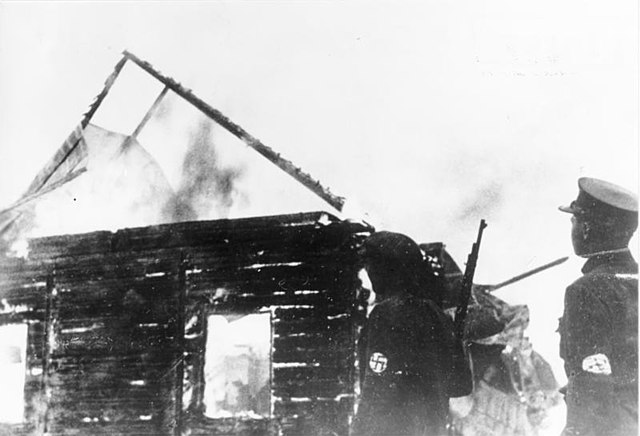Content deleted Content added
m |
|||
Line 33: ===The Holocaust events=== The Lithuanian port city of [[Klaipėda|Klaipėda (Memel in German)]] had historically been a member of the German Hanseatic League, and had belonged to Germany and East Prussia prior to 1918. The city was semi-autonomous during the period of Lithuanian independence, and under League of Nations supervision. Approximately 8,000 Jews lived in Memel when it was absorbed into the Reich on March 15, 1939. Its Jewish residents were expelled, and most fled into Lithuania proper Chronologically, the genocide in Lithuania can be divided into three phases: phase 1. summer to the end of 1941; phase 2. December 1941 – March 1943; phase 3. April 1943 – mid-July 1944.<ref name="Bubnys_vanished205-206">{{cite book|first=Arūnas |last=Bubnys |chapter=Holocaust in Lithuania: An Outline of the Major Stages and Their Results |title=The Vanished World of Lithuanian Jews |publisher=Rodopi |year=2004| isbn=978-90-420-0850-2 |chapter-url=https://books.google.com/books?id=mdXRKbcyi5oC&pg=PA205 |pages=205–206}}</ref> ▲The Lithuanian port city of [[Klaipėda|Klaipėda (Memel in German)]] had historically been a member of the German Hanseatic League, and had belonged to Germany and East Prussia prior to 1918. The city was semi-autonomous during the period of Lithuanian independence, and under League of Nations supervision. Approximately 8,000 Jews lived in Memel when it was absorbed into the Reich on March 15, 1939. Its Jewish residents were expelled, and most fled into Lithuania proper. In 1941, German killing squads, the [[Einsatzgruppen]], followed the advance of the German army units and immediately began organizing the murder of Jews.<ref name="Porat159"/> [[File:Massacre of Jews in Lietūkis garage.jpeg|thumb|Massacre of Jews by Lithuanians at Lietūkis garage on 27 June 1941 during the [[Kaunas pogrom]]]]
Most Lithuanian Jews perished in the first phase during the first months of the occupation and before the end of 1941. The [[Operation Barbarossa|Axis invasion of the USSR]] began on June 22, 1941 and coincided with the [[June Uprising in Lithuania]]. During the days prior to the German occupation of Lithuania the [[Lithuanian Activist Front]] attacked Soviet forces, seized power in several cities, spread anti-Semitic propaganda and carried out massacres of Lithuanian Jews and Poles. One notable massacre began on the night of 25–26 June when [[Algirdas Klimaitis]] ordered his 800 Lithuanian troops to begin the [[Kaunas pogrom]]. [[Franz Walter Stahlecker]], the [[SS]] commanding officer of [[Einsatzgruppe A]] claimed that by 28 June 1941 3,800 people had been killed in Kaunas and a further 1,200 in surrounding towns in the region.<ref name=Gitelman>{{cite book | first=Zvi |last=Gitelman |authorlink =Zvi Gitelman | title =Bitter Legacy: Confronting the Holocaust in the USSR | year =1998 | publisher =Indiana University Press | isbn =0-253-33359-8| url =https://books.google.com/books?id=USW9-xQ85FwC&pg=PA97 | pages =97, 102}}</ref> Klimaitis' men destroyed several synagogues and about sixty Jewish houses. In the 1990s the number of victims claimed by Stahlecker were questioned and thought to have been probably exaggerated.<ref name=Bubnys>{{cite journal | first=Arūnas |last=Bubnys |authorlink =Arūnas Bubnys | title =Vokiečių ir lietuvių saugumo policija (1941–1944) (German and Lithuanian security police: 1941–1944) | year=1997 |volume=I | journal =Genocidas ir rezistencija |issn=1392-3463 | url =http://www.genocid.lt/Leidyba/1/arunas1.htm | accessdate =2006-06-09 |language=lt}}</ref>
Two factors contributed to the rapid destruction of Lithuanian Jewry. The first was the significant support for the "de-Jewification" of Lithuania coming from the Lithuanian populace.<ref name="Porat166"/><ref name="Bubnys_vanished214"/> The second was the German plan for early colonization of Lithuania – which shared a border with German [[East Prussia]] – in accordance with their [[Generalplan Ost]]; hence the high priority given to the extermination of the relatively small Lithuanian Jewish community.<ref name="Bubnys_vanished214"/> | |||
 Article Images
Article Images